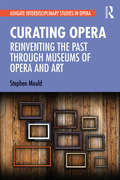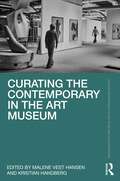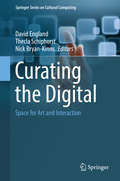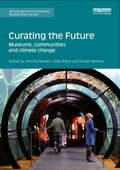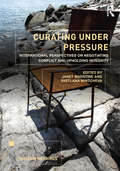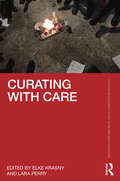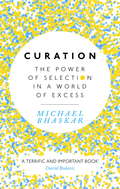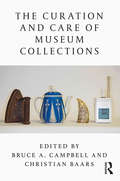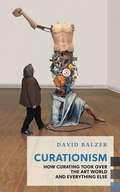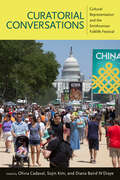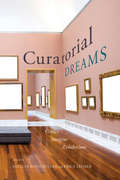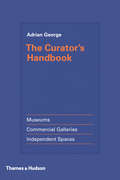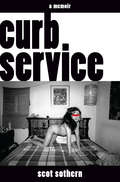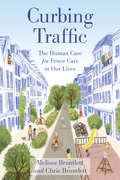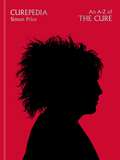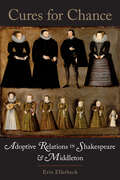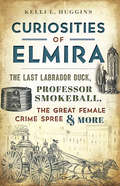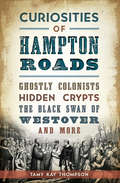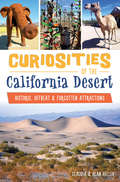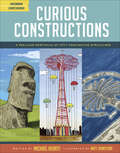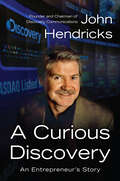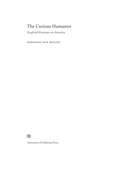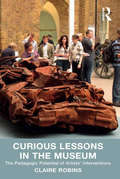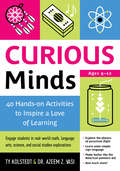- Table View
- List View
Curating Opera: Reinventing the Past Through Museums of Opera and Art (Ashgate Interdisciplinary Studies in Opera)
by Stephen MouldCuration as a concept and a catchword in modern parlance has, over recent decades, become deeply ingrained in modern culture. The purpose of this study is to explore the curatorial forces at work within the modern opera house and to examine the functionaries and processes that guide them. In turn, comparisons are made with the workings of the traditional art museum, where artworks are studied, preserved, restored, displayed and contextualised – processes which are also present in the opera house. Curatorial roles in each institution are identified and described, and the role of the celebrity art curator is compared with that of the modern stage director, who has acquired previously undreamt-of licence to interrogate operatic works, overlaying them with new concepts and levels of meaning in order to reinvent and redefine the operatic repertoire for contemporary needs. A point of coalescence between the opera house and the art museum is identified, with the transformation, towards the end of the nineteenth century, of the opera house into the operatic museum. Curatorial practices in the opera house are examined, and further communalities and synergies in the way that ‘works’ are defined in each institution are explored. This study also considers the so-called ‘birth’ of opera around the start of the seventeenth century, with reference to the near-contemporary rise of the modern art museum, outlining operatic practice and performance history over the last 400 years in order to identify the curatorial practices that have historically been employed in the maintenance and development of the repertoire. This examination of the forces of curation within the modern opera house will highlight aspects of authenticity, authorial intent, preservation, restoration and historically informed performance practice.
Curating the Contemporary in the Art Museum (Routledge Research in Art Museums and Exhibitions)
by Malene Vest HansenCurating the Contemporary in the Art Museum investigates the art museum as a space where the contemporary is staged – in exhibitions, collecting practices, communication, and policies. Curating the Contemporary in the Art Museum traces the art museum back to the postwar era. Including contributions by established and emerging art historians, academics and curators, the book proposes that the art museum is engaged in the contemporary in a double sense: it (re)presents contemporary art, while the contemporary condition itself also has a significant impact on art and the museum that houses it. Presenting a diverse range of international cases of exhibitions and curatorial practices, which hail primarily from Europe and Scandinavia, the essays examine the politics of staging “national”, “international”, and “global” framings of modernism, as well as the new public spaces shaped in digital practices and changing political frameworks. The book investigates both the seminal and the unknown exhibitions and institutions that created contemporary art as we know it today. Curating the Contemporary in the Art Museum provides a historical perspective on the museum of contemporary art. It constitutes a step towards differencing the canon of modernist and contemporary art and a more complex understanding of the politics of curating the contemporary in the art museum, why it will be of interest to academics and students engaged in the study of museums, curating, exhibitions, and art history.
Curating the Digital: Space for Art and Interaction (Springer Series on Cultural Computing #0)
by David England Thecla Schiphorst Nick Bryan-KinnsThis bookcombines work from curators, digital artists, human computer interactionresearchers and computer scientists to examine the mutual benefits andchallenges posed when working together to support digital art works in theirmany forms. In Curating the Digitalwe explore how we can work together to make space for art and interaction. Welook at the various challenges such as the dynamic nature of our media, theproblems posed in preserving digital art works and the thorny problems of howwe assess and measure audience's reactions to interactive digital work. Curating the Digital is an outcome of a multi-disciplinary workshop that took place atSICHI2014 in Toronto. The participants from the workshop reflected on the themeof Curating the Digital via a series of presentations and rapid prototypingexercises to develop a catalogue for the future digital art gallery. Theresults produce a variety of insights both around the theory and philosophy ofcurating digital works, and also around the practical and technicalpossibilities and challenges. We present these complimentary chapters so thatother researchers and practitioners in related fields will find motivation andimagination for their own work.
Curating the Future: Museums, Communities and Climate Change (Routledge Environmental Humanities)
by Jennifer Newell Libby Robin Kirsten WehnerCurating the Future: Museums, Communities and Climate Change explores the way museums tackle the broad global issue of climate change. It explores the power of real objects and collections to stir hearts and minds, to engage communities affected by change. Museums work through exhibitions, events, and specific collection projects to reach different communities in different ways. The book emphasises the moral responsibilities of museums to address climate change, not just by communicating science but also by enabling people already affected by changes to find their own ways of living with global warming. There are museums of natural history, of art and of social history. The focus of this book is the museum communities, like those in the Pacific, who have to find new ways to express their culture in a new place. The book considers how collections in museums might help future generations stay in touch with their culture, even where they have left their place. It asks what should the people of the present be collecting for museums in a climate-changed future? The book is rich with practical museum experience and detailed projects, as well as critical and philosophical analyses about where a museum can intervene to speak to this great conundrum of our times. Curating the Future is essential reading for all those working in museums and grappling with how to talk about climate change. It also has academic applications in courses of museology and museum studies, cultural studies, heritage studies, digital humanities, design, anthropology, and environmental humanities.
Curating Under Pressure: International Perspectives on Negotiating Conflict and Upholding Integrity (Museum Meanings)
by Janet Marstine Svetlana MintchevaCurating Under Pressure breaks the silence surrounding curatorial self-censorship and shows that it is both endemic to the practice and ubiquitous. Contributors map the diverse forms such self-censorship takes and offer creative strategies for negotiating curatorial integrity. This is the first book to look at pressures to self-censor and the curatorial responses to these pressures from a wide range of international perspectives. The book offers examples of the many creative strategies that curators deploy to negotiate pressures to self-censor and gives evidence of curators’ political acumen, ethical sagacity and resilience over the long term. It also challenges the assumption that self-censorship is something to be avoided at all costs and suggests that a decision to self-censor may sometimes be politically and ethically imperative. Curating Under Pressure serves as a corrective to the assumption that censorship pressures render practitioners impotent. It demonstrates that curatorial practice under pressure offers inspiring models of agency, ingenuity and empowerment. Curating Under Pressure is a highly original and intellectually ambitious volume and as such will be of great interest to students and academics in the areas of museum studies, curatorial and gallery studies, art history, studio art and arts administration. The book will also be an essential tool for museum practitioners.
Curating with Care (Routledge Research in Art Museums and Exhibitions)
by Elke Krasny Lara PerryThis book presents over 20 authors’ reflections on ‘curating care’ – and presents a call to give curatorial attention to the primacy of care for all life and for more ‘caring curating’ that responds to the social, ecological and political analysis of curatorial caregiving. Social and ecological struggles for a different planetary culture based on care and respect for the dignity of life are reflected in contemporary curatorial practices that explore human and non-human interdependence. The prevalence of themes of care in curating is a response to a dual crisis: the crisis of social and ecological care that characterizes global politics and the professional crisis of curating under the pressures of the increasingly commercialized cultural landscape. Foregrounding that all beings depend on each other for life and survival, this book collects theoretical essays, methodological challenges and case studies from curators working in different global geographies to explore the range of ways in which curatorial labour is rendered as care. Practising curators, activists and theorists situate curatorial labour in the context of today’s general care crisis. This volume answers to the call to more fully understand how their transformative work allows for imagining the future of bodily, social and environmental care and the ethics of interdependency differently.
Curation: The power of selection in a world of excess
by Michael Bhaskar'A terrific and important book . . . it's a great, fresh take on how the 21st century is transforming the way we select everything from food to music' David Bodanis, author of E=MC2In the past two years humanity has produced more data than the rest of human history combined. We carry a library of data in our pockets, accessible at any second. We have more information and more goods at our disposal than we know what to do with. There is no longer any competitive advantage in creating more information. Today, value lies in curation: selecting, finding and cutting down to show what really matters.Curation reveals how a little-used word from the world of museums became a crucial and at times controversial strategy for the twenty-first century. Today's most successful companies - Apple, Netflix, Amazon - have used curation to power their growth, by offering customers more tailored and appropriate choices.Curation answers the question of how we can live and prosper in an age of information overload. In the context of excess, it is not only a sound business strategy, but a way to make sense of the world.
The Curation and Care of Museum Collections
by Bruce A Campbell Christian BaarsMuseum curators enter the profession with a specialist subject qualification and yet at some point in their career, many curators find themselves in charge of a range of collections outside of their expert knowledge. Interpreting, curating and caring for mixed collections demands of curators a wide range of knowledge and understanding. The Curation and Care of Museum Collections is designed to give curators the fundamental information and confidence they need to manage and care for all of the collections within their responsibility, regardless of their previous training and experience. Comprising two sections – Museum Collections, and Collection Development and Care – the chapters cover archaeology, art, history, military and natural sciences collections, as well as heritage properties. Every chapter in the book is focused on one type of collection, but all chapters in the collection management section contain advice on topics such as organisational philosophy, documentation, legal issues and materials in order to provide a useful and comprehensive guide to managing collections. The collection care section is structured in the same way, considering the issues of storage; display; handling; moving; packing; housekeeping; health and safety; emergency preparedness; and pest, pollution, environmental, light and vibration management. The contributors to this book are experienced museum professionals, each with their own specialism and a deep understanding of what it means to work in the context of mixed collections. Providing a highly practical guide, The Curation and Care of Museum Collections is essential reading for curators working in all types of museums, galleries and heritage sites, and for students of museology courses around the world.
Curationism: How Curating Took Over the Art World and Everything Else (Exploded Views)
by David Balzer"Now that we 'curate' even lunch, what happens to the role of the connoisseur in contemporary culture?'Curate' is now a buzzword applied to everything from music festivals to artisanal cheese. Inside the art world, the curator reigns supreme, acting as the face of high-profile group shows and biennials in a way that can eclipse and assimilate the contributions of individual artists. At the same time, curatorial studies programs continue to grow in popularity, and businesses are increasingly adopting curation as a means of adding value to content and courting demographics. Everyone, it seems, is a now a curator. But what is a curator, exactly? And what does the explosive popularity of curating say about our culture's relationship with taste, labour and the avant-garde?In this incisive and original study, critic David Balzer travels through art history and around the globe to explore the cult of curation - where it began, how it came to dominate museums and galleries, and how it was co-opted at the turn of the millennium as the dominant mode of organizing and giving value to content. At the centre of the book is a paradox: curation is institutionalized and expertise-driven like never before, yet the first independent curators were not formally trained, and any act of choosing has become 'curating.' Is the professional curator an oxymoron? Has curation reached a sort of endgame, where its widespread fetishization has led to its own demise?David Balzer has contributed to publications including the Believer, Modern Painters, Artforum.com, and The Globe and Mail, and is the author of Contrivances, a short-fiction collection. He is currently Associate Editor at Canadian Art magazine. Balzer was born in Winnipeg and currently resides in Toronto, where he makes a living as a critic, editor and teacher.
Curatorial Conversations: Cultural Representation and the Smithsonian Folklife Festival
by Olivia Cadaval Sojin Kim Diana Baird N’DiayeSince its origins in 1967, the Smithsonian Folklife Festival has gained worldwide recognition as a model for the research and public presentation of living cultural heritage and the advocacy of cultural democracy. Festival curators play a major role in interpreting the Festival's principles and shaping its practices. Curatorial Conversations brings together for the first time in one volume the combined expertise of the Festival's curatorial staff—past and present—in examining the Center for Folklife and Cultural Heritage’s representation practices and their critical implications for issues of intangible cultural heritage policy, competing globalisms, cultural tourism, sustainable development and environment, and cultural pluralism and identity. In the volume, edited by the staff curators Olivia Cadaval, Sojin Kim, and Diana Baird N’Diaye, contributors examine how Festival principles, philosophical underpinnings, and claims have evolved, and address broader debates on cultural representation from their own experience. This book represents the first concerted project by Smithsonian staff curators to examine systematically the Festival’s institutional values as they have evolved over time and to address broader debates on cultural representation based on their own experiences at the Festival.
Curatorial Dreams: Critics Imagine Exhibitions
by Shelley Ruth Butler Erica LehrerWhat if museum critics were challenged to envision their own exhibitions? In Curatorial Dreams, fourteen authors from disciplines throughout the social sciences and humanities propose exhibitions inspired by their research and critical concerns to creatively put theory into practice. Pushing the boundaries of museology, this collection gives rare insight into the process of conceptualizing exhibitions. The contributors offer concrete, innovative projects, each designed for a specific setting in which to translate critical academic theory about society, culture, and history into accessible imagined exhibitions. Spanning Australia, Barbados, Canada, Chile, the Netherlands, Poland, South Africa, Switzerland, and the United States, the exhibitions are staged in museums, scientific institutions, art galleries, and everyday sites. Essays explore political and practical constraints, imaginative freedom, and experiment with critical, participatory, and socially relevant exhibition design. While the deconstructive critique of museums remains relevant, Curatorial Dreams charts new ground, proposing unique modes of engagement that enrich public scholarship and dialogue.
Curatorial Dreams: Critics Imagine Exhibitions
by Erica Lehrer Shelley ButlerWhat if museum critics were challenged to envision their own exhibitions? In Curatorial Dreams, fourteen authors from disciplines throughout the social sciences and humanities propose exhibitions inspired by their research and critical concerns to creatively put theory into practice. Pushing the boundaries of museology, this collection gives rare insight into the process of conceptualizing exhibitions. The contributors offer concrete, innovative projects, each designed for a specific setting in which to translate critical academic theory about society, culture, and history into accessible imagined exhibitions. Spanning Australia, Barbados, Canada, Chile, the Netherlands, Poland, South Africa, Switzerland, and the United States, the exhibitions are staged in museums, scientific institutions, art galleries, and everyday sites. Essays explore political and practical constraints, imaginative freedom, and experiment with critical, participatory, and socially relevant exhibition design. While the deconstructive critique of museums remains relevant, Curatorial Dreams charts new ground, proposing unique modes of engagement that enrich public scholarship and dialogue.
The Curator's Handbook
by Adrian GeorgeA step-by-step guide to every aspect of putting on an art exhibition, with tips from a range of influential curators The Curator's Handbook is the essential handbook for curators and curatorial students, mapping every stage of the process of putting on an exhibition, no matter how traditional the venue, from initial idea to final installation. An introduction explores curatorial work from its origins in the seventeenth century onward and outlines the various roles of the curator today. Twelve chapters then trace the various stages of the exhibition process in clear, informative language and using helpful diagrams and tables, from developing the concept to writing contracts and loan requests; putting together budgets and schedules; producing exhibition catalogues and interpretation materials; designing gallery spaces; working with artists, lenders, and art handlers; organizing private views; and documenting and evaluating a show. With advice and tips from a cast of international museum directors and curators--including Daniel Birnbaum (Moderna Museet, Stockholm); Aric Chen (M+, Hong Kong); Elizabeth Macgregor (Museum of Contemporary Art, Sydney); Hans Ulrich Obrist (Serpentine Gallery, London); Gao Peng (Today Art Museum, Beijing); Jennifer Russell (Metropolitan Museum of Art, New York); and Nicholas Serota (Tate, London)--this volume is a crucial guide for anyone involved in, or studying, the dynamic field of curation.
Curb Service: A Memoir
by Scot SothernCruising nighttime byways for an adrenaline fix, Scot Sothern first patronized the marketplace of curbside prostitution surfing the prurient whims of a young man. He dove to the murky depths of sexual obsession and resurfaced five years later, shell-shocked and without excuse. While there, trusty Nikon in hand, Scot, a second-generation photographer, made full-frontal X-rated exposures, black and white, filled with pathos and an uncanny realism. The pictures captured the plight of the disenfranchised in America, those forgotten and drug-addicted. Now he is ready to tell the story behind the photographs, the confessions of a befuddled baby-boomer maintaining a slippery connection to propriety while side-tripping into noirish infatuations with those low in life. Curb Service recounts Sothern's past as a troubled kid in the 1960s who visited two-dollar whorehouses and as an adult in the 1980s is still at it. A photographer who either can't get a break or blows it when one comes his way, Scot wants to hold onto jobs, wives, and relationships; he tries to be a good father to the son he loves. Yet he continues picking up street prostitutes, photographing them, having sex with them, living moments of their lives and watching them fade away in a culture that deems them criminal and expendable. It was only a few years ago that Scot's photography started to receive notice - by influential Drkrm Gallery in Los Angeles - which led to the publication of Lowlife, a photo book, by Stanley Barker in the UK and soon by powerhouse in Brooklyn. His work has since been exhibited world-wide including shows in London, Los Angeles, and Ottawa.
Curbing Traffic: The Human Case for Fewer Cars in Our Lives
by Melissa Bruntlett Chris BruntlettIn Curbing Traffic: The Human Case for Fewer Cars in Our Lives, mobility experts Melissa and Chris Bruntlett chronicle their experience living in the Netherlands and the benefits that result from treating cars as visitors rather than owners of the road. They weave their personal story with research and interviews with experts and Delft locals to help readers share the experience of living in a city designed for people. Their insights will help decision makers and advocates to better understand and communicate the human impacts of low-car cities: lower anxiety and stress, increased independence, social autonomy, inclusion, and improved mental and physical wellbeing. Curbing Traffic provides relatable, emotional, and personal reasons why it matters and inspiration for exporting the low-car city.
Curepedia: An A-Z of The Cure
by Simon PriceThe Cure are arguably the biggest alternative rock band in the world. Between 1985 and 2000 every album they released went to at least Gold in the UK, the US or both. In America they have earned four Platinum albums, and they are estimated to have sold 30 million albums worldwide. Their iconic status as elder statesmen of Alternative Rock remains undiminished - if anything, their tireless touring has ensured that it has grown with every passing year - and lead singer Robert Smith is an endlessly fascinating figure to successive generations of fans. The Cure's influence reverberates through genres including Emo, Goth, Industrial and Indie Rock.The book is an encyclopaedic A-Z of The Cure examining and riffing on miscellaneous trivia, biographies of the band members past and present, summaries of each album and selected songs, details of the band's various tours and films, and essays on broader topics such as their image, their politics and their influences. Playful, eccentric and irreverent - true to the spirit of the band itself - CUREPEDIA is a comprehensive biography of one of the biggest alternative rock bands in the world. The hardback edition features interior pages printed in red and black ink, a ribbon marker, and bespoke C-U-R-E letter endpapers specially designed by Andy Vella - celebrated artist and collaborator (as part of Parched Art) with The Cure on their album artwork for four decades.
Cures for Chance: Adoptive Relations in Shakespeare and Middleton
by Erin EllerbeckAdoption allows families to modify, either overtly or covertly, what is considered to be the natural order. Cures for Chance explores how early modern English theatre questioned the inevitability of the biological family and proposed new models of familial structure, financial inheritance, and gendered familial authority. Because the practice of adoption circumvents sexual reproduction, its portrayal obliges audiences to reconsider ideas of nature and kinship. This study elucidates the ways in which adoptive familial relations were defined, described, and envisioned on stage, particularly in the works of Shakespeare and Middleton. In the plays in question, families and individual characters create, alter, and manage familial relations. Throughout Cures for Chance, adoption is considered in the broader socioeconomic and political climate of the period. Literary works and a wide range of other early modern texts – including treatises on horticulture and natural history and household and conduct manuals – are analysed in their historical and cultural contexts. Erin Ellerbeck argues that dramatic representations of adoption test conventional notions of family by rendering the family unit a social construction rather than a biological certainty, and that in doing so, they evoke the alteration of nature by human hands that was already pervasive at the time.
Curiosities of Elmira: The Last Labrador Duck, Professor Smokeball, the Great Female Crime Spree & More
by Kelli L. HugginsLong known as the “Queen City” of New York’s Southern Tier, Elmira has a colorful history to live up to that name. Strange events and offbeat characters populate the city’s past. Eldridge Park once had a violent bear pit. The mysterious extinction of the Labrador Duck still baffles researchers today. Inventor Henry Clum, forgotten in time, was a pioneer of meteorology. From the bright lights of the city’s lost vaudeville stages to the dark corners of the criminal underworld, Elmirans have found fame and infamy. Author Kelli Huggins takes readers on an immersive journey into the curious and unique past of Elmira.
Curiosities of Hampton Roads: Ghostly Colonists, Hidden Crypts, the Black Swan of Westover, and More
by Tamy Kay ThompsonFacts and photos highlighting the haunting side of Virginia&’s Tidewater . . . The history of Hampton Roads is as deep as the waters that surround it. From some of the first settlers in the New World to the formation of the nation, Virginia&’s Tidewater is rich in curious tales of legends and lore. In the Southside, the famed pirate Blackbeard was beheaded by Captain Maynard of Hampton. Captain John Smith was a part of the first governing body in America formed in Jamestown. The nation&’s oldest mental institution still stands in Williamsburg. Staff and guests at Boxwood Inn in Newport News have reported hauntings from a former owner and other eerie occurrences. In this offbeat travel guide, author Tamy Kay Thompson covers these stories and more as she takes readers on a journey through the always entertaining past of Hampton Roads.
Curiosities of the California Desert: Historic, Offbeat & Forgotten Attractions
by Claudia HellerOne might not expect to find much in the middle of California's hot, dry deserts. But to the curious explorer, they're scattered with strange and extraordinary sights. On old Route 66, the desert traveler can find quirky roadside art and mementos left by motorists. In the El Paso Mountains of the Mojave, the daring adventurer can crawl through a tunnel that was hand dug by an old prospector named Burro Schmidt. In Landers, the weary wanderer can enjoy a rejuvenating "sound bath" in an acoustically perfect dome supposedly designed by aliens. From astounding natural wonders to remnants of ancient civilizations and the Wild West, discover treasures of history, puzzling mystery and uncommon eccentricity alongside seasoned road trippers Alan and Claudia Heller.
Curious Constructions: A Peculiar Portfolio of Fifty Fascinating Structures (Uncommon Compendiums)
by Michael HearstAn illustrated collection of unusual architecture, perfect for young builders, written with a &“wry humor&” that is sure to &“keep readers entertained&” (Publishers Weekly). Curious about constructions? Inside this book, you&’ll come face-to-face with fifty incredible structures, including: a fire-breathing octopus sculpture; the skateboard ramp you&’d need to jump the Great Wall of China; a whole community of tree houses in Costa Rica; and a life-size X-Wing Starfighter built of Legos. These and many more fascinating accounts of constructions both fantastically useful and gloriously unnecessary await inquisitive readers, aspiring engineers, and anyone who ever looked at a skyscraper and thought, &“Yeah, but what if it had a roller coaster on top?&” &“Hearst obviously had a lot of fun compiling this interesting assortment of man-made creations, making great use of wit and puns.&” —School Library Journal
A Curious Discovery: An Entrepreneur's Story
by John S. HendricksIn A Curious Discovery, media titan John Hendricks tells the remarkable story of building one of the most successful media empires in the world, Discovery Communications.John Hendricks, a well-respected corporate leader and brand builder, reveals that his professional achievements would not have been possible without one crucial quality that has informed his life since childhood: curiosity. This entrepreneur’s story takes you behind the scenes of some of the network’s most popular shows and greatest successes, and imparts crucial lessons from the network’s setbacks.With insights, anecdotes, photographs, and real-world wisdom, A Curious Discovery is more than a powerful autobiography and corporate history: It also a valuable primer for business innovators and entrepreneurs.
The Curious Humanist: Siegfried Kracauer in America
by Johannes Von MoltkeDuring the Weimar Republic, Siegfried Kracauer established himself as a trenchant theorist of film, culture, and modernity, and he is now considered one of the key thinkers of the twentieth century. When he arrived in Manhattan aboard a crowded refugee ship in 1941, however, he was virtually unknown in the United States and had yet to write his best-known books, From Caligari to Hitler and Theory of Film. Johannes von Moltke details the intricate ways in which the American intellectual and political context shaped Kracauer's seminal contributions to film studies and shows how, in turn, Kracauer's American writings helped shape the emergent discipline. Using archival sources and detailed readings, von Moltke asks what it means to consider Kracauer as the New York Intellectual he became in the last quarter century of his life. Adopting a transatlantic perspective on Kracauer's work, von Moltke demonstrates how he pursued questions in conversation with contemporary critics from Theodor Adorno to Hannah Arendt, from Clement Greenberg to Robert Warshow: questions about the origins of totalitarianism and the authoritarian personality; about high and low culture; about liberalism, democracy, and what it means to be human. From these wide-flung debates, Kracauer's own voice emerges as that of an incisive cultural critic invested in a humanist understanding of the cinema.
Curious Lessons in the Museum: The Pedagogic Potential of Artists' Interventions
by Claire RobinsAmongst recent contemporary art and museological publications, there have been relatively few which direct attention to the distinct contributions that twentieth and twenty-first century artists have made to gallery and museum interpretation practices. There are fewer still that recognise the pedagogic potential of interventionist artworks in galleries and museums. This book fills that gap and demonstrates how artists have been making curious but, none-the-less, useful contributions to museum education and curation for some time. Claire Robins investigates in depth the phenomenon of artists' interventions in museums and examines their pedagogic implications. She also brings to light and seeks to resolve many of the contradictions surrounding artists' interventions, where on the one hand contemporary artists have been accused of alienating audiences and, on the other, appear to have played a significant role in orchestrating positive developments to the way that learning is defined and configured in museums. She examines the disruptive and parodic strategies that artists have employed, and argues for that they can be understood as part of a move to re-establish the museum as a discursive forum. This valuable book will be essential reading for students and scholars of museum studies, as well as art and cultural studies.
Curious Minds: 40 Hands-on Activities to Inspire a Love of Learning
by Ty Kolstedt Dr Azeem Z. VasiA multidisciplinary activity book from four core academic areas--math, science, language arts, and social studiesUnlike the many activity books devoted solely to one type of activity--science experiments, art activities, math games, brain teasers, and the like--Curious Minds takes a multidisciplinary approach, incorporating science, social studies, math, language arts, world languages, and more in 40 hands-on activities that promote kids' critical thinking and engaged interest in the world they live in. Designed for teachers, parents, or homeschoolers searching for new ways to motivate students aged 9-12, this illustrated resource provides a short mini-lesson for each activity, giving educational background information, related lingo, a materials list, step-by-step directions, and guidance for extending the activity. The wide range of activities--from exploring the physics of parachute flight to making homemade ink to testing how pollutants affect plants--ensures every learner's interest will be piqued.
